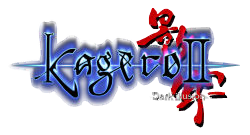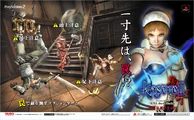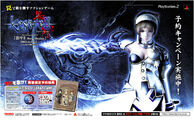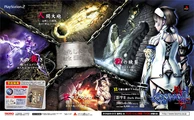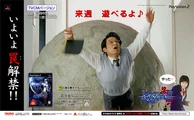| "Offer your soul..." |
| Trapt | |
|---|---|
| Japanese name | 影牢II -Dark illusion- |
| Romaji name | Kagero II: Dark illusion |
| Developer | Tecmo |
| Publisher | Tecmo |
| Release Dates | PlayStation 2 version
|
| Genre | Action-Strategy |
| Game Modes | Single player |
| Ratings | ESRB: Mature CERO: Ages 15 and up PEGI: 12 |
| Platforms | PlayStation 2 |
Trapt (stylized as TЯAPT), known as Kagero II: Dark illusion (影牢II -Dark illusion-, lit. "Shadow Prison II: Dark illusion") in Japan, is the fourth game in the Deception series, released for PlayStation 2 in 2005.
The player assumes the role of Allura, a princess that has been framed for the murder of her father King Olaf. On the night of the King's murder, Allura is accused of killing him by her stepmother, Catalina. With the help of her friend Rachel, Allura is able to escape into a forest. On the run from assassins, she acquires the ability to set a series of traps, which is the only means she has of defending herself from her pursuers.
Gameplay[]
Players begin by equipping and making traps for Allura to take with her into the game mission. Each mission starts in a specific room, where players can position traps in order to defeat enemies. The traps are classified into three types according to where they can be positioned within the game world (wall, ceiling, and floor). The player is allowed to take up to three traps of each type into a game stage, and additional traps can be obtained by completing the game. Enemies' life bars are shown at the top of the screen, while Allura's life bar and active traps are shown at the bottom left and right respectively. As the player defeats enemies they are rewarded with "warl", the game's currency, which can be used to purchase new traps between missions. Players may also purchase room keys, which allow Allura to access other rooms in the game missions. Apart from the main story missions, the game also includes several "side stories", which are optional missions that give different angles and insights into the game's main story. There are three official endings in the game, and a fourth that is not registered when saved onto the game file.
Apart from regular traps, Trapt introduces "Dark Illusions", which are pre-existing traps found throughout the mansion. Each is located in a different room and has a different effect upon an enemy. Each Dark Illusion requires certain criteria to be fulfilled before activation and can only be used once per level.
Chapters[]
- Chapter 1: Unravelled
- Chapter 2: The Soul's Price
- Chapter 3: The Sinful
- Chapter 4: The Shackles of Fate
- Chapter 5: The Martyr
- Chapter 6: The Remaining Path
- Chapter 7: Respective Thoughts
- Chapter 8: Pale Inheritance
- Chapter 9: The Road to Destruction
- Chapter 10: Those Who Seek Power
- Chapter 11: Mother
- Chapter 12: The Ties that Bind
- Chapter 13: Protector
- Chapter 14: Acceptance
- Chapter 15: The Broken Throne
Development[]
Producer Keisuke Kikuchi renamed the game Trapt from its original title of Deception 4 because he considered it the first part of a new series.[1] The development team used existing torture devices and historical items as the basis for the traps found in the game, collecting books and photographs for reference.[2] These traps were modified "so that they would be good for a video game".[2] Most of the traps were generated from the staffs' own ideas, some others were inspired by comic books and films.[2] Two weeks were spent creating an initial pool of 720 trap ideas, after a few days deliberation and examination it was decided that 45 traps would be needed. A number of further screening processes were needed to bring down the total to 45.[3] Hitoshi Hasegawa (the game's Director of Development and Promotion) stated that the "killer clock" Dark Illusion was inspired by the anime, The Castle of Cagliostro[4]. The more advanced PlayStation 2 graphics, compared to those of the original PlayStation which previous Deception games were developed for, resulted in some traps being toned down due to them being considered too grotesque.[5]
The developers experienced difficulty in creating the enemies' artificial intelligence, due to each enemy behaving differently depending on their personality. Some characters remember where traps have been placed if they had previously fallen victim to them, and avoid passing through the same location or make "comical moves" to evade them. The team "had a lot of fun tailoring and adjusting the AI to suit these funnier moments."[2] All the characters in the game, including the minor characters that Allura encounters, have background stories. Hasegawa noted that this is "one of the features that the Deception series is renowned for in Japan."[2] The team's purpose for doing so is because of they "want the player to defeat their enemies, but to also feel guilty about doing this."
Gallery[]
- Main article: Trapt/Images
Reception[]
Trapt received a mixed but mostly average reaction from the game critic community, having a Metacritic aggregate score of 60.[6] Reviewers generally agreed that the overall content of the game is acceptable; however, several issues with technical stability and a poor translation from its original Japanese language reduces its quality. The amount of slowdown (drop in frame rate) caused by activating traps, in particular, drew criticism from reviewers, Greg Mueller of GameSpot stated: "The frame rate comes grinding to a halt whenever traps are activated."[7] Louis Bedigian of GameZone also noted the slowdown, suggesting that with the already slow pace of gameplay it "could be summed up as being a wait and see RTS."[8] Kristian Reed of Eurogamer said the game suffers from a "rubbish camera system and an all-round feel of technical impoverishment."[9] VideoGamer.com reviewer Tom Orry found the in-game camera "awful" and "by far the biggest problem."[10]
Despite the technical issues, Trapt was praised for its uniqueness on the PlayStation 2 platform, as well as the game's premise of killing Allura's pursuers, though most reviewers found faults which detracted from their lasting impressions. Chris Roper of IGN commented "death and destruction is always good fun. If that's all your expecting from Trapt, you'll likely have a good time with it."[11] GameSpy's Benjamin Turner found the game to be "a decent execution of a fairly original concept, at least when it's not bombarding the player with questionable movie scenes."[12] 1up.com writer Richard Li said the game encouraged players to find inventive ways to kill enemies but added: "It's fun at first, but its flaws prevent it from being a spectacular and memorable experience."[13] IGN's Chris Roper described it as "...good fun overall", adding "Beating the crap out of people is always rewarding in some way, and Trapt provides you with multiple options to do so."[14]
Though some critics did appreciate the retention of the original Japanese voice acting,[10][15] several expressed disdain for the game's poor "Engrish" translation.[7][9][13] Several other aspects of the game received criticism, such as the limited number of traps available and enemies' intelligence.[8][14] The game's plot has been described as "tediously unengaging"[9] and "fairly short and almost unintelligible".[7]
External links[]
References[]
- ↑ "Fatally Trapt: The Keisuke Kikuchi Interview" ([https://web.archive.org/web/20090615054232/http://www.gameinformer.com/News/Story/200506/N05.0629.1812.37894.htm archived). GameInformer.)
- ↑ 2.0 2.1 2.2 2.3 2.4 Stahie, Silviu (2006-02-24). "Trapt Development Team Q&A With Tecmo's Hitoshi Hasegawa.". Softpedia.
- ↑ "TRAPT Dev Diary #2 (PS2)". GameSpy.
- ↑ "Cliff Hanger 1983 Arcade Game (Final Level 7 THE END! :))". YouTube.
- ↑ "TGS 2004: Kagero II: Dark Illusion - First Look". IGN.
- ↑ "Trapt Reviews". Metacritic.
- ↑ 7.0 7.1 7.2 "Trapt Review". GameSpot.
- ↑ 8.0 8.1 "Trapt Review". GameZone.
- ↑ 9.0 9.1 9.2 "Trapt". Eurogamer.
- ↑ 10.0 10.1 "Trapt Review for PS2". VideoGamer.com.
- ↑ "Trapt". IGN.
- ↑ "TЯAPT review". GameSpy.
- ↑ 13.0 13.1 "Trapt (PS2)". 1up.com.
- ↑ 14.0 14.1 "TЯAPT review". IGN.
- ↑ "Reviews - Trapt". Grrl Gamer.[dead link]
[]
Trapt
|
|---|
| Characters |
| Major Characters |
| Allura Rachel • Catalina • Hertzog • Jais • Finnegan • Ada • Olaf • Malphas |
| Minor Characters |
| Bertran • Graines • Kendal • Mayte • Millennia • Silvoff |
| Terms |
| Traps |
| Locations |
| Fronenberg |


